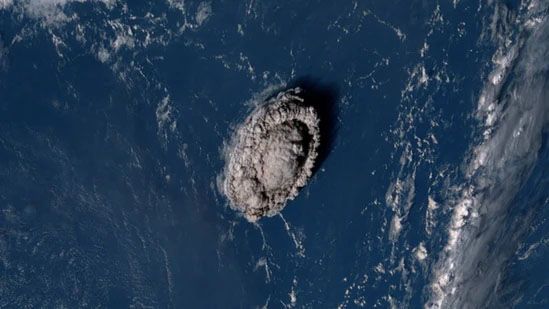The eruption in Hunga Tonga Hunga Ha’apai volcano in southern Pacific Island of Tonga was no small event. It triggered tsunami waves around the Pacific and smothered Tonga in dust.
The eruption on Saturday was so powerful that it was recorded around the world and sent pressure shockwaves around the planet twice.
As more and more details emerge about the natural incident, here’s a look at what a volcanic eruption is and the global impact of that happened in Tonga.
What is a volcanic eruption?
Before we talk about volcanic eruptions, it is important to understand what a volcano is. A volcano is an opening or rupture in the earth’s surface that allows magma – which comes out as hot liquid and semi-liquid rock – volcanic ash and gases to escape.
The volcanic hotspots are places which are found where Earth’s tectonic plates come together.
A volcanic eruption is when lava and gas are released from a volcano – sometimes explosively.
Undersea volcanic eruption
This type of eruption happens in a volcano which is located under the ocean surface. There are an estimated one million undersea volcanoes, and most of them are located near the tectonic plates.
Apart from lava, these openings also spew out ash. These deposit on the ocean’s floor and lead to the formation of sea mounds – underwater mountains that are formed on the ocean floor but do not reach the water surface.
How many active volcanoes are there on Earth?
According to USGS, there are about 1,350 potentially active volcanoes worldwide. About 500 of those have erupted, according to data available with USGS. Many of those are located along the Pacific Rim in what is known as the “Ring of Fire”.
Impact of volcanic eruption on Earth’s climate
Huge volcanic eruptions can sometimes cause temporary global cooling as sulfur dioxide is pumped into the stratosphere. But in the case of the Tonga eruption, initial satellite measurements indicated the amount of sulfur dioxide released would only have a tiny effect of perhaps 0.01 Celsius (0.02 Fahrenheit) global average cooling, said Alan Robock, a professor at Rutgers University.
What happened in Tonga?
Satellite images showed the spectacular undersea eruption on Saturday evening, with a plume of ash, steam and gas rising like a giant mushroom above the South Pacific waters.
A sonic boom was heard as far away as Alaska.
Some climate experts said that the eruption altered atmospheric pressure that may have briefly helped clear out the fog in Seattle, in the United States.
Tsunami waves of about 80 centimeters (2.7 feet) crashed into Tonga’s shoreline, and New Zealand Prime Minister Jacinda Ardern described damage to boats and shops on Tonga’s shoreline.
The waves crossed the Pacific, drowning two people in Peru and causing minor damage from New Zealand to Santa Cruz, California.
The US Geological Survey estimated the eruption caused the equivalent of a magnitude 5.8 earthquake.

